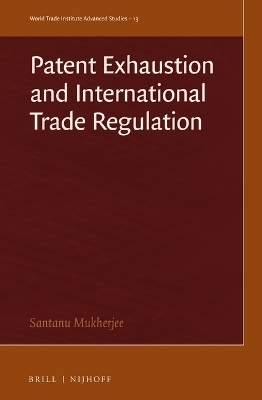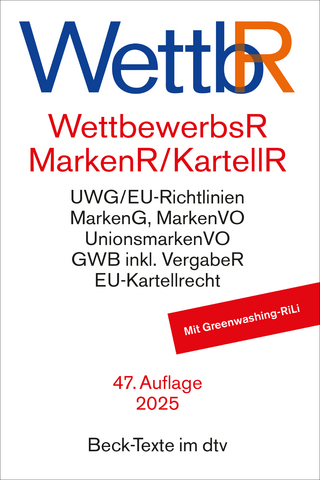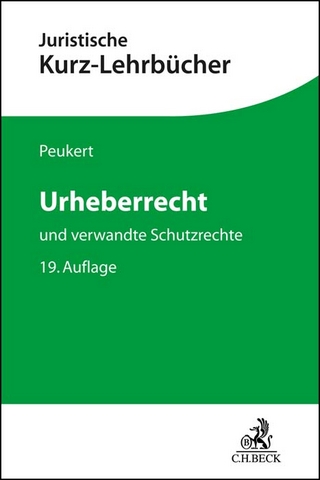
Patent Exhaustion and International Trade Regulation
Martinus Nijhoff (Verlag)
978-90-04-54280-8 (ISBN)
This book dives into the legal and economic rationale of patent exhaustion, studying its evolution from the beginning in Germany, UK and USA, to Japan and 10 developing countries. The author also analyses exhaustion under TRIPS, GATT, GATS and major regional agreements, including the EU, before assessing the interface of patent exhaustion with competition policy. The book also addresses public policy concerns of Least developed and developing countries linked to their IPR challenges as IP users. It concludes that an appropriate exhaustion mode under relevant legal measures would protect patents while also restraining patents to become non-tariff barriers.
The open access publication of this book has been published with the support of the Swiss National Science Foundation.
Santanu Mukherjee, M.I.L.E., Ph.D. (WTI, Bern University), is an Advocate & Accredited Mediator in India, and the Head of Ex Lege Chambers, a boutique Law Office. He specializes in IPR, International Trade Policy and Technology Laws.
Foreword
Preface
Acknowledgments
List of Figures and Table
Abbreviations and Acronyms
Introduction
Part 1
Patents and Exhaustion
1 Intellectual Property Rights and Patents: Introduction to Intellectual Property Rights
1.1 Brief History of Patents
1.2 Rationale for Patents
1.2.1 Libertarian
1.2.2 Self-expression
1.2.3 Utilitarian
1.2.4 Human Rights
1.2.5 Distributive Justice
1.2.6 Privacy
1.2.7 Egalitarian
1.3 Specific Characteristics of Intellectual Property Rights
2 Ubiquity and Exhaustion Doctrine: Ubiquity in Patents
2.1 Doctrine of Implied License
2.2 Doctrine of First Sale
2.3 Exhaustion of Patent Rights
3 Economics of Patents and Economic Rationale for Exhaustion in Relation to International Trade
3.1
3.1.1 The Economics of Patents
3.1.2 The Economic Arguments for Free Trade in Relation to Exhaustion of Patents
3.2 The Economic Reasoning for Patent Exhaustion
3.2.1 Economic Reasoning for ‘National Exhaustion’ of Patent Rights
3.2.2 Economic Reasoning for ‘International Exhaustion’ of Patent Rights
3.2.3 Economic Reasoning for ‘Regional Exhaustion’ of Patent Rights
3.2.4 Ideal Mode of Patent Exhaustion among the Three Modes
4 Evolution of Exhaustion: Patent Exhaustion in Different Jurisdictions
4.1 The United Kingdom and the Doctrine of ‘Implied License’
4.2 Patent Exhaustion in Germany and Some Countries in Continental Europe
4.3 Patent Exhaustion in the United States of America
4.4 Patent Exhaustion in Japan
4.5 Patent Exhaustion in Some Developing Countries
4.5.1 Brazil
4.5.2 China
4.5.3 India
4.5.4 South Africa
4.5.5 Indonesia
4.5.6 Malaysia
4.5.7 Singapore
4.5.8 Thailand
4.5.9 The Philippines
4.5.10 Vietnam
5 Exhaustion and Parallel Trade: Patent Exhaustion
5.1 The Effect of Patent Exhaustion on Parallel Trade
5.2 The Effect of Exhaustion of Other ipr s on Parallel Trade
5.2.1 Exhaustion of Trademarks
5.2.2 Exhaustion of Copyrights
5.2.3 Exhaustion of Trademarks and Copyrights in Relation to Patent Exhaustion and Effect on Parallel Trade
Part 2
Multilateral and Regional Trade Regulations and Patent Exhaustion
6 trips Agreement: The Negotiating History of the trips Agreement and Patent Exhaustion
6.1 Intellectual Property Rights under the gatt and the Negotiating History of trips
6.2 The Negotiating History of Exhaustion
6.3 Exhaustion under trips / wto: Analysis from the Multilateral Trade Perspective
6.3.1 Patent Exhaustion under the trips Agreement
7 gatt 1994 and Exhaustion
7.1 Preamble to the gatt 1994
7.2 Article i – Most Favoured Nation
7.3 Article iii – National Treatment
7.4 Article xx – General Exceptions
7.5 Article xi: 1 – General Elimination of Quantitative Restrictions
7.6 Article xxiv – In Light of the Most Favoured Nation Principle
7.7 Article xxiii: 1 – Non-discrimination of Quantitative Restrictions
8 General Agreement on Trade in Services and Its Interface with Patent Exhaustion
8.1 gats and Patent Exhaustion
8.2 Article ii and Article xvii in gats and Its Impact on Patent Exhaustion
8.3 Exceptions to Most Favoured Nation and National Treatment and Its Impact on Patent Exhaustion under Article v and Article xiv
9 Free Trade Agreements and Exhaustion: Different Regional Trade Agreements
9.1
9.1.1 Regionalism and Its Relationship with Multilateralism
9.1.2 Development of Regionalism in Different Parts of the World
9.1.3 Relation between Regionalism and Multilateralism with Reference to Articles xiv and xxiv of the gatt / wto Agreement
9.2 The European Union, European Free Trade Association, European Economic Area and Patent Exhaustion
9.3 North American Free Trade Area (nafta), United States Canada Mexico Agreement (usmca) and Patent Exhaustion
9.3.1 nafta: Historical Perspective and Evolution
9.3.2 nafta: Legal rules on Intellectual Property Rights and Patent Exhaustion
9.3.3 usmca: Background and Evolution
9.4 Association of Southeast Asian Nations (asean) and Patent Exhaustion
9.5 Gulf Cooperation Council (gcc) and Patent Exhaustion
9.6 Common Market of the South (mercosur) and Patent Exhaustion
9.7 Comprehensive and Progressive Agreement for Trans-pacific Partnership (cptpp), ipr s and Patent Exhaustion
9.8 Comprehensive Economic and Trade Agreement (ceta) and Patent Exhaustion
Part 3
Policy Dimensions of Patent Exhaustion
10 Patents and Public Health: Patents and Access to Medicines – The Exhaustion Dimension
10.1 Historical Perspective of Patents, Public Health Concerns and Access to Medicines: The Indian Experience
10.2 Post-trips Scenario: Patents, Public Health Concerns and Access to Medicines
10.3 Public Policy Implications of Public Health Crisis Leading to trips Amendment
10.4 trips Amendment: Patent Exhaustion Enabling Parallel Trade
11 Exhaustion and Competition Policy: Patent Exhaustion and Its Relation with Competition Law and Policy
11.1 Competition Law and Policy in the Multilateral Trading System
11.2 Competition Law/Policy and ipr s within the gatt/wto Regime
11.3 Competition Law/Policy trips and Parallel Imports
Conclusion and Final Remarks
12 Conclusion and Recommendation: Adoption of International Exhaustion of Patents, Globally
12.1. Purpose of Patent Protection, Ubiquity and Need for Balance
12.2 Patent Exhaustion in Different Countries: Need for Uniform International Exhaustion
12.3 Patent Exhaustion and Multilateral Trade: Need for Removal of Non-Tariff Barriers
12.4 International Exhaustion of Patents – Balancing ipr Protection and Consumer Welfare through Competition Policy
12.5 Addressing Parallel Imports under State Control and Restraints on Intellectual Property Rights
12.5.1 Restraint on Parallel Imports Due to Non-existence of Patents in Country of Export or Patents being Subject to Compulsory Licenses and Other Controls
12.5.2 Restraint on Parallel Imports due to Inferior Quality of Products
12.6 Amendment of the trips Agreement: Proposed Draft Amended Text for Article 6, trips
Bibliography
Legal Texts and wto Documents
List of Cases
Websites
Index
| Erscheinungsdatum | 04.04.2023 |
|---|---|
| Reihe/Serie | World Trade Institute Advanced Studies ; 13 |
| Sprache | englisch |
| Maße | 155 x 235 mm |
| Gewicht | 709 g |
| Themenwelt | Recht / Steuern ► EU / Internationales Recht |
| Recht / Steuern ► Wirtschaftsrecht ► Urheberrecht | |
| ISBN-10 | 90-04-54280-9 / 9004542809 |
| ISBN-13 | 978-90-04-54280-8 / 9789004542808 |
| Zustand | Neuware |
| Haben Sie eine Frage zum Produkt? |
aus dem Bereich


